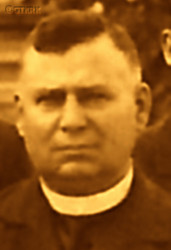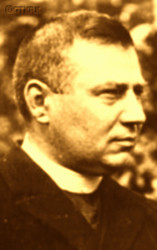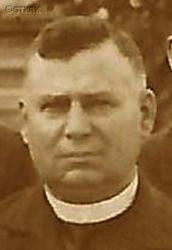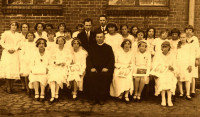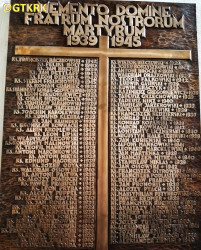Roman Catholic
St Sigismund parish
05-507 Słomczyn
85 Wiślana Str.
Konstancin deanery
Warsaw archdiocese, Poland
full list:
displayClick to display full list

searchClick to search full list by categories
wyświetlKliknij by wyświetlić pełną listę po polsku

szukajKliknij by przeszukać listę wg kategorii po polsku

Martyrology of the clergy — Poland
XX century (1914 – 1989)
personal data
surname
WIERZCHOWSKI
forename(s)
Fabian Sebastian
function
diocesan priest
creed
Latin (Roman Catholic) Church RCmore on
en.wikipedia.org
[access: 2014.09.21]
diocese / province
Culm (Chełmno) diocesemore on
pl.wikipedia.org
[access: 2012.11.23]
date and place
of death
22.07.1940

KL Sachsenhausenconcentration camp
today: Sachsenhausen‐Oranienburg, Oberhavel dist., Brandenburg state, Germany
more on
en.wikipedia.org
[access: 2018.11.18]
alt. dates and places
of death
20.08.1940
details of death
After the abdication of the German Emperor William II Hohenzollern on 09.11.1918, after the armistice between the Allies and Germany signed on 11.11.1918 in the HQ wagon in Compiègne, the HQ of French Marshal Ferdinand Foch — which de facto meant the end of World War I; after transfer of the supreme authority over the Polish army to Brigadier Joseph Piłsudski as its commander‐in‐chief — which de facto meant the rebirth of the Polish state ‐ member of the District People's Council in Starogard Gdański, established in response to the disclosure on 11.11.1918 in Poznań, in the Prussian/German partition, of the Polish People's Council, opting for Poland.
After German invasion of Poland on 01.09.1939 (Russians invaded Poland 17 days later) and start of the World War II, after start on 04.09.1939 of German occupation of Grudziądz arrested by the Germans but soon released.
Went into hiding.
In 02.1940 turned himself in to Bp Splett who sent him to Skórcz as parish priest.
Soon however on 11.03.1940 arrested in Skórcz.
Transported to KL Stutthof concentration camp and from there on 09‐10.04.1940 to KL Sachsenhausen concentration camp where perished.
According to the death certificate in the books of the Germ. Standesamt (Eng. registry office) in Oranienburg, No. 3550/40, the „honest” otherwise German „medical doctors” and formalists — and at the same time, unrivaled fairy tale spinners — noted that the cause of death was Germ. „Lungenentzündung, Darmkatarrch” (Eng. „Pneumonia, intestinal catarrh”).
prisoner camp's numbers
21266Click to display source page (KL SachsenhausenClick to display the description)
cause of death
extermination: exhaustion and starvation
perpetrators
Germans
sites and events
KL SachsenhausenClick to display the description, KL StutthofClick to display the description, «Intelligenzaktion»Click to display the description, Ribbentrop‐MolotovClick to display the description, Pius XI's encyclicalsClick to display the description
date and place
of birth
20.01.1887Birth certification on:
www.genealogiawarchiwach.pl
[access: 2025.11.05]

Wąbrzeźnotoday: Wąbrzeźno urban gm., Wąbrzeźno pov., Kuyavia‐Pomerania voiv., Poland
more on
en.wikipedia.org
[access: 2021.09.02]
parents
WIERZCHOWSKI Peter
🞲 ?, ? — 🕆 ?, ?

WĄSIKOWSKA Victoria Josefa
🞲 ?, ? — 🕆 ?, ?
presbyter (holy orders)
ordination
09.03.1913

Pelplintoday: Pelplin gm., Tczew pov., Pomerania voiv., Poland
more on
en.wikipedia.org
[access: 2021.05.06]
St Barbara RC chapelmore on
pl.wikipedia.org
[access: 2021.12.19] (in Theological Seminary)
positions held
1940
administrator — Skórcztoday: Skórcz urban gm., Starogard Gdański pov., Pomerania voiv., Poland
more on
en.wikipedia.org
[access: 2021.09.02] ⋄ All the Saints RC parish ⋄ Osiektoday: Osiek gm., Starogard Gdański pov., Pomerania voiv., Poland
more on
en.wikipedia.org
[access: 2021.09.02] RC deanery
1935 – 1939
prefect — Grudziądztoday: Grudziądz city pov., Kuyavia‐Pomerania voiv., Poland
more on
en.wikipedia.org
[access: 2021.09.02] ⋄ King Jan III Sobieski's State Gymnasium and Classic High School — also: teacher of introductory philosophy and headmaster of the gymnasium (1937‐1938)
president — Grudziądztoday: Grudziądz city pov., Kuyavia‐Pomerania voiv., Poland
more on
en.wikipedia.org
[access: 2021.09.02] ⋄ Pomeranian Circle, Union of Prefect Priests
1923 – 1935
prefect — Gniewtoday: Gniew gm., Tczew pov., Pomerania voiv., Poland
more on
en.wikipedia.org
[access: 2021.07.29] ⋄ State Humanities and Coeducation Lower gymnasium — from c. 1928 formally „professor” in schools, in accordance with Art. 8 of the 01.07.1926 Act of Polish Parlament; also: temporary manager (c. 1928, c. 1932), teacher of Latin language
1921 – 1923
vicar — Nowe Miasto Lubawskietoday: Nowe Miasto Lubawskie urban gm., Nowe Miasto Lubawskie pov., Warmia‐Masuria voiv., Poland
more on
en.wikipedia.org
[access: 2021.09.02] ⋄ St Thomas the Apostle RC parish ⋄ Nowe Miasto Lubawskietoday: Nowe Miasto Lubawskie urban gm., Nowe Miasto Lubawskie pov., Warmia‐Masuria voiv., Poland
more on
en.wikipedia.org
[access: 2021.09.02] RC deanery
1918 – 1921
administrator — Pączewotoday: Skórcz gm., Starogard Gdański pov., Pomerania voiv., Poland
more on
en.wikipedia.org
[access: 2022.01.28] ⋄ Annunciation to the Blessed Virgin Mary RC parish ⋄ Gniewtoday: Gniew gm., Tczew pov., Pomerania voiv., Poland
more on
en.wikipedia.org
[access: 2021.07.29] RC deanery
vicar — Chojnicetoday: Chojnice urban gm., Chojnice pov., Pomerania voiv., Poland
more on
en.wikipedia.org
[access: 2021.09.02] ⋄ Beheading of St John the Baptist RC parish ⋄ Człuchówtoday: Człuchów gm., Człuchów pov., Pomerania voiv., Poland
more on
en.wikipedia.org
[access: 2021.09.02] RC deanery
1916 – 1917
administrator — Stężycatoday: Stężyca gm., Kartuzy pov., Pomerania voiv., Poland
more on
en.wikipedia.org
[access: 2021.09.02] ⋄ St Catherine of Alexandria the Virgin and Martyr RC parish ⋄ Mirachowotoday: Kartuzy gm., Kartuzy pov., Pomerania voiv., Poland
more on
en.wikipedia.org
[access: 2020.11.27] RC deanery
vicar — Strzepcztoday: Linia gm., Wejherowo pov., Pomerania voiv., Poland
more on
en.wikipedia.org
[access: 2021.09.02] ⋄ St Mary Magdalene RC parish ⋄ Mirachowotoday: Kartuzy gm., Kartuzy pov., Pomerania voiv., Poland
more on
en.wikipedia.org
[access: 2020.11.27] RC deanery
1913 – 1915
vicar — Luzinotoday: Luzino gm., Wejherowo pov., Pomerania voiv., Poland
more on
en.wikipedia.org
[access: 2021.09.02] ⋄ St Lawrence the Martyr RC parish ⋄ Mirachowotoday: Kartuzy gm., Kartuzy pov., Pomerania voiv., Poland
more on
en.wikipedia.org
[access: 2020.11.27] RC deanery
1909 – 1913
student — Pelplintoday: Pelplin gm., Tczew pov., Pomerania voiv., Poland
more on
en.wikipedia.org
[access: 2021.05.06] ⋄ philosophy and theology, Theological Seminary
1908 – 1909
student — Munichtoday: Bavaria state, Germany
more on
en.wikipedia.org
[access: 2022.04.12] ⋄ Germ. Ludwig–Maximilians–Universität (Eng. Ludwig Maximilian University)
1916 – 1921
membership — Toruńtoday: Toruń city pov., Kuyavia‐Pomerania voiv., Poland
more on
en.wikipedia.org
[access: 2021.06.20] ⋄ scientific society
others related
in death
ADAMCZYKClick to display biography Stanislav, BRZĄKAŁAClick to display biography Victor, BURCZYKClick to display biography Felix, BYTOFClick to display biography Peter, CHARSZEWSKIClick to display biography Paulinus Ignatius, CHYLARECKIClick to display biography Stanislav, CIEMNIAKClick to display biography Louis, CYBULSKIClick to display biography Stanislav, CZAKIClick to display biography Saturnin, CZAPIEWSKIClick to display biography Joseph Leonard, DEMSKIClick to display biography Vladislav, DOERINGClick to display biography Alexander, FIGATClick to display biography Henry, GOŃCZClick to display biography Bernard Ambrose, GORALClick to display biography Vladislav, GRZEBIELEWSKIClick to display biography Joseph, GUZClick to display biography Joseph Adalbert (Fr Innocent), HEVELKEClick to display biography Alexander Eugene John Oscar, HINZClick to display biography Francis Felix, HINZClick to display biography Thaddeus, JARZĘBSKIClick to display biography Stanislav Romualdo, JORDANClick to display biography Boleslav, KALINOWSKIClick to display biography Theodore, KARAMUCKIClick to display biography Edmund Leo, KARCZYŃSKIClick to display biography Cyril Methodius, KAŹMIERCZAKClick to display biography Bronislav Anthony, KLEINClick to display biography John Matthias, KOMPFClick to display biography January Sigismund, KONKOLEWSKIClick to display biography Joachim, KOWNACKIClick to display biography Bronislav, KOZUBEKClick to display biography Roman, KRAUZEClick to display biography Edmund, KRUPIŃSKIClick to display biography Louis, KUBIAKClick to display biography John (Bro. Norbert Mary), KUBICKIClick to display biography Steven Adam Marian, KUBISTAClick to display biography Stanislav, KUPILASClick to display biography Francis, LAPISClick to display biography Casimir, LENARTClick to display biography John, LICZNERSKIClick to display biography Constantine John, ŁOSIŃSKIClick to display biography Bernard Anthony, MACIĄTEKClick to display biography Stanislav Paul, MARCHLEWSKIClick to display biography Leonard, MATUSZEWSKIClick to display biography Francis Adam, MĄKOWSKIClick to display biography John, MĘŻNICKIClick to display biography Joseph, MICHNOWSKIClick to display biography Marian John, MITRĘGAClick to display biography Francis, MORKOWSKIClick to display biography Edmund, MOŚCICKIClick to display biography Joseph, NAGÓRSKIClick to display biography Paul Adalbert, NITSCHMANNClick to display biography Adam Robert, NOWAŃSKIClick to display biography Anthony, NOWICKIClick to display biography Alexander, OCHOŃSKIClick to display biography Charles Joseph (Fr Chris), OKOŁO–KUŁAKClick to display biography Anthony, PALUCHOWSKIClick to display biography Boleslav, PETRYKOWSKIClick to display biography Steven, PIASZCZYŃSKIClick to display biography Michael, PODLASZEWSKIClick to display biography Francis, POMIANOWSKIClick to display biography Vladislav, RADTKEClick to display biography Steven Boleslav, SĄSAŁAClick to display biography Theodore, SKOBLEWSKIClick to display biography Mieczyslav, SKOWRONClick to display biography Casimir, SOCHACZEWSKIClick to display biography Bronislav Peter, SWINARSKI–PORAJClick to display biography Nicholas Ignatius Bogusław, SYNOWIECClick to display biography Boleslav, SZUKALSKIClick to display biography John Wladysław, SZYMAŃSKIClick to display biography Bruno Peter John, ŚLEDZIŃSKIClick to display biography Joseph Marian, TUSZYŃSKIClick to display biography Joseph, TYMIŃSKIClick to display biography Anthony, WAWRZYNOWICZClick to display biography John, WĄSOWICZClick to display biography Sigismund, WIERZBICKIClick to display biography Sigismund Lawrence, WILLIMSKYClick to display biography Albert, WŁODARCZYKClick to display biography Ignatius, WOHLFEILClick to display biography Robert, WRÓBLEWSKIClick to display biography Bronislav, ZAWISZAClick to display biography Valentine, ZIELIŃSKIClick to display biography Paul Nicholas, ZIEMSKIClick to display biography Alexander Felix, ZIENKOWSKIClick to display biography Vaclav, ŻUCHOWSKIClick to display biography Vaclav
sites and events
descriptions
KL Sachsenhausen: In Germ. Konzentrationslager (Eng. concentration camp) KL Sachsenhausen, set up in the former Olympic village in 07.1936, hundreds of Polish priests were held in 1940, before being transported to KL Dachau. Some of them perished in KL Sachsenhausen. Murderous medical experiments on prisoners were carried out in the camp. In 1942‐1944 c. 140 prisoners slaved at manufacturing false British pounds, passports, visas, stamps and other documents. Other prisoners also had to do slave work, for Heinkel aircraft manufacturer, AEG and Siemens among others. On average c. 50,000 prisoners were held at any time. Altogether more than 200,000 inmates were in jailed in KL Sachsenhausen and its branched, out of which tens of thousands perished. Prior to Russian arrival mass evacuation was ordered by the Germans and c. 80,000 prisoners were marched west in so‐called „death marches” to other camps, i.e. KL Mauthausen‐Gusen and KL Bergen‐Belsen. The camp got liberated on 22.04.1945. After end of armed hostilities Germans set up there secret camp for German prisoners and „suspicious” Russian soldiers. (more on: en.wikipedia.orgClick to attempt to display webpage
[access: 2018.11.18])
KL Stutthof: In German Germ. Konzentrationslager (Eng. concentration camp) KL Stutthof (then in Eastern Prussian belonging to Germany, today: Sztutowo village) concentration camp, that Germans started to build on 02.09.1939, a day after German invasion of Poland and start of the World War II, Germans held c. 110,000‐127,000 prisoners from 28 countries, including 49,000 women and children. C. 65,000 victims were murdered and exterminated. In the period of 25.01‐27.04.1945 in the face of approaching Russian army Germans evacuated the camp. When on 09.05.1945 Russians soldiers entered the camp only 100 prisoners were still there. In an initial period (1939‐1940) Polish Catholic priests from Pomerania were held captive there before being transported to KL Dachau concentration camp. Some of them were murdered in KL Stutthof or vicinity (for instance in Stegna forest). Also later some Catholic priests were held in KL Stutthof. (more on: stutthof.orgClick to attempt to display webpage
[access: 2018.11.18], en.wikipedia.orgClick to attempt to display webpage
[access: 2013.07.06])
«Intelligenzaktion»: German: «Intelligenzaktion» (English: „Intelligence Action”) — a German program of extermination of the Polish elite, mainly the intelligentsia and leadership layers, carried out from the beginning of the occupation in w 09.1939 to 04.1940, mainly in territories directly annexed to Germany, but also in the so‐called Germ. Generalgouvernement (Eng. General Governorate), where it was called «AB‐aktion». In the first phase, immediately after the beginning of the German occupation, during military operations carried out by the Germ. Wehrmacht (Eng. Armed Forces) and the genocidal units of the Germ. Einsatzgruppen (Eng. Operational Groups) of the Germ. Sicherheitspolizei (Eng. Security Police), i.e. SiPo, and Germ. Sicherheitsdienst des Reichsführers SS (Eng. Security Service of the Reichsführer SS), i.e. SD, organized by the Germ. Reichssicherheitshauptamt (Eng. Reich Main Security Office), i.e. RSHA, which followed the troops, carried out under the Germ. Unternehmen „Tannenberg” (Eng. Operation „Tannenberg”) — based on the so‐called Germ. Sonderfahndungsliste (Eng. Special Wanted Lists), i.e. proscription lists of Poles considered particularly dangerous to the Third Reich, prepared by the Zentralstelle II/P (Polen) unit of the German RSHA. Later, implemented by the German civilian occupation authorities and the genocidal unit of the Germ. Volksdeutscher Selbstschutz (Eng. Ethnic Germans Self‐Defense), whose members were Germ. Volksdeutsche (Eng. Ethnic Germans), i.e. representatives of the German minority in Poland. According to various sources, these lists, at the beginning of 09.1939, could have contained the details of 61,000—88,000 „dangerous” Poles — although these figures cannot be confirmed. In total, during this genocide, c. 50,000 teachers, Catholic priests, representatives of the landed gentry, freelancers, social and political activists, and retired military personnel were systematically and methodically murdered. Another 50,000 were sent to concentration camps, where only a negligible percentage survived. (more on: en.wikipedia.orgClick to attempt to display webpage
[access: 2014.10.04])
Ribbentrop‐Molotov: Genocidal Russian‐German alliance pact between Russian leader Joseph Stalin and German leader Adolf Hitler signed on 23.08.1939 in Moscow by respective foreign ministers, Mr. Vyacheslav Molotov for Russia and Joachim von Ribbentrop for Germany. The pact sanctioned and was the direct cause of joint Russian and German invasion of Poland and the outbreak of the World War II in 09.1939. In a political sense, the pact was an attempt to restore the status quo ante before 1914, with one exception, namely the „commercial” exchange of the so‐called „Kingdom of Poland”, which in 1914 was part of the Russian Empire, fore Eastern Galicia (today's western Ukraine), in 1914 belonging to the Austro‐Hungarian Empire. Galicia, including Lviv, was to be taken over by the Russians, the „Kingdom of Poland” — under the name of the General Governorate — Germany. The resultant „war was one of the greatest calamities and dramas of humanity in history, for two atheistic and anti‐Christian ideologies — national and international socialism — rejected God and His fifth Decalogue commandment: Thou shall not kill!” (Abp Stanislav Gądecki, 01.09.2019). The decisions taken — backed up by the betrayal of the formal allies of Poland, France and Germany, which on 12.09.1939, at a joint conference in Abbeville, decided not to provide aid to attacked Poland and not to take military action against Germany (a clear breach of treaty obligations with Poland) — were on 28.09.1939 slightly altered and made more precise when a treaty on „German‐Russian boundaries and friendship” was agreed by the same murderous signatories. One of its findings was establishment of spheres of influence in Central and Eastern Europe and in consequence IV partition of Poland. In one of its secret annexes agreed, that: „the Signatories will not tolerate on its respective territories any Polish propaganda that affects the territory of the other Side. On their respective territories they will suppress all such propaganda and inform each other of the measures taken to accomplish it”. The agreements resulted in a series of meeting between two genocidal organization representing both sides — German Gestapo and Russian NKVD when coordination of efforts to exterminate Polish intelligentsia and Polish leading classes (in Germany called «Intelligenzaktion», in Russia took the form of Katyń massacres) where discussed. Resulted in deaths of hundreds of thousands of Polish intelligentsia, including thousands of priests presented here, and tens of millions of ordinary people,. The results of this Russian‐German pact lasted till 1989 and are still in evidence even today. (more on: en.wikipedia.orgClick to attempt to display webpage
[access: 2015.09.30])
Pius XI's encyclicals: Facing the creation of two totalitarian systems in Europe, which seemed to compete with each other, though there were more similarities than contradictions between them, Pope Pius XI issued in 03.1937 (within 5 days) two encyclicals. In the „Mit brennender Sorge” (Eng. „With Burning Concern”) published on 14.03.1938, condemned the national socialism prevailing in Germany. The Pope wrote: „Whoever, following the old Germanic‐pre‐Christian beliefs, puts various impersonal fate in the place of a personal God, denies the wisdom of God and Providence […], whoever exalts earthly values: race or nation, or state, or state system, representatives of state power or other fundamental values of human society, […] and makes them the highest standard of all values, including religious ones, and idolizes them, this one […] is far from true faith in God and from a worldview corresponding to such faith”. On 19.03.1937, published „Divini Redemptoris” (Eng. „Divine Redeemer”), in which criticized Russian communism, dialectical materialism and the class struggle theory. The Pope wrote: „Communism deprives man of freedom, and therefore the spiritual basis of all life norms. It deprives the human person of all his dignity and any moral support with which he could resist the onslaught of blind passions […] This is the new gospel that Bolshevik and godless communism preaches as a message of salvation and redemption of humanity”… Pius XI demanded that the established human law be subjected to the natural law of God , recommended the implementation of the ideal of a Christian state and society, and called on Catholics to resist. Two years later, National Socialist Germany and Communist Russia came together and started World War II. (more on: www.vatican.vaClick to attempt to display webpage
[access: 2023.05.28], www.vatican.vaClick to attempt to display webpage
[access: 2023.05.28])
sources
personal:
www.niedziela.diecezja.torun.plClick to attempt to display webpage
[access: 2013.08.31], www.bibliotekagniew.plClick to attempt to display webpage
[access: 2015.09.30], www.genealogiawarchiwach.plClick to attempt to display webpage
[access: 2025.11.05], www.niedziela.diecezja.torun.plClick to attempt to display webpage
[access: 2013.01.13]
bibliographical:
„Biographical dictionary of priests of the Chełmno diocese ordained in the years 1821‐1920”, Henry Mross, Pelplin, 1995
„International Tracing Service (ITS), Bad Arolsen, GermanyClick to display source page”, Arolsen Archives
original images:
www.bibliotekagniew.plClick to attempt to display webpage
[access: 2015.09.30], gdansk.ipn.gov.plClick to attempt to display webpage
[access: 2020.10.02]
LETTER to CUSTODIAN/ADMINISTRATOR
If you have an Email client on your communicator/computer — such as Mozilla Thunderbird, Windows Mail or Microsoft Outlook, described at WikipediaPatrz:
en.wikipedia.org, among others — try the link below, please:
LETTER to CUSTODIAN/ADMINISTRATORClick and try to call your own Email client
If however you do not run such a client or the above link is not active please send an email to the Custodian/Administrator using your account — in your customary email/correspondence engine — at the following address:

giving the following as the subject:
MARTYROLOGY: WIERZCHOWSKI Fabian Sebastian
To return to the biography press below:
 Click to return to biography
Click to return to biography








